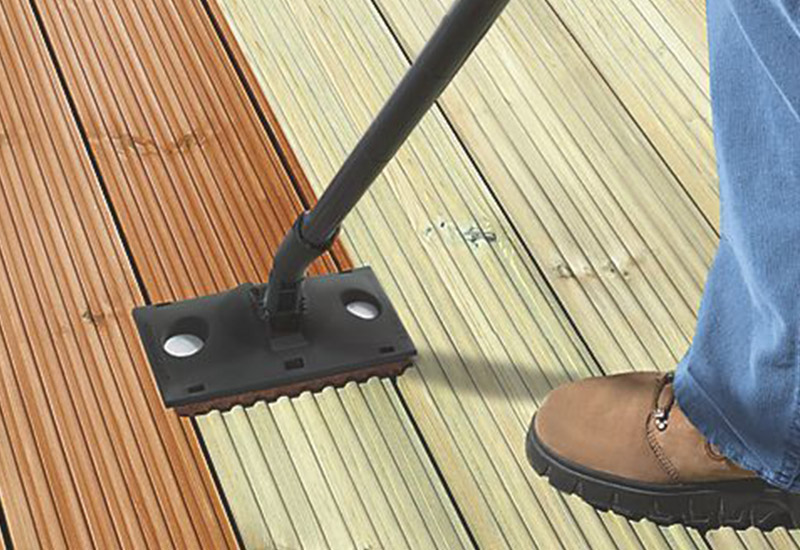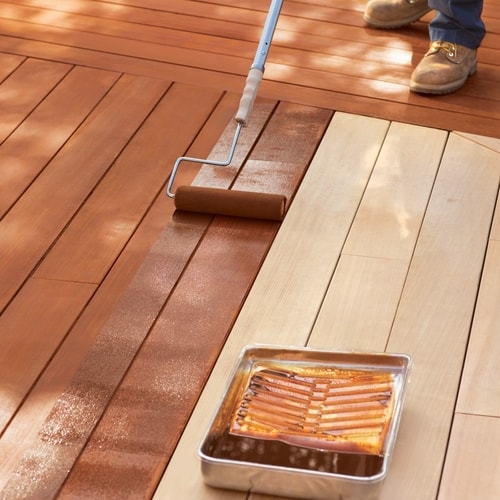Beautiful Deck Layouts: The Influence of the Right Stain Selection
Wiki Article
A Comprehensive Overview to Different Sorts Of Deck Discoloration Techniques for Ultimate Security and Visual Appeals
In the realm of deck upkeep, the art of tarnishing stands as a critical action in the direction of both protecting the honesty of your exterior area and improving its visual charm. As we navigate through the complex world of deck discoloration methods, one begins to appreciate the nuanced strategies that can make all the difference between a mediocre coating and a remarkable one. From the choice of the proper discolor kind to the meticulous application approaches, each aspect plays a critical function in attaining that ideal equilibrium between protection and aesthetics. Join us as we discover the tricks behind achieving the supreme deck staining results-- a journey where every brushstroke shapes not simply the surface, yet the extremely essence of your outdoor refuge.Recognizing Different Sorts Of Spots
Various kinds of stains are generally utilized in the process of deck staining to attain different visual and protective results. Transparent discolorations are excellent for showcasing the natural grain of the timber while providing marginal protection versus UV rays and dampness. On the other hand, semi-transparent spots offer a balance in between color enhancement and security, permitting some wood grain to show via. For a much more nontransparent coating that provides optimum defense against the aspects, strong stains are the favored selection. These stains are available in a variety of shades and effectively conceal the timber grain.Toners include a hint of shade to the timber while giving marginal security, making them appropriate for newer decks with less wear. Understanding the qualities and benefits of each type of tarnish is essential for accomplishing the desired appearance and longevity for your deck.
Choosing the Right Stain Shade
When thinking about the aesthetics of your deck staining job, the selection of discolor color plays an important duty in boosting the safety qualities of the chosen tarnish kind (Right Deck Stain). The color you choose can significantly influence the general look of your deck, along with its capability to stand up to the elements with timeWhen choosing a stain shade, it's important to consider the existing color pattern of your home's outside. Harmonizing the deck tarnish with the general aesthetic of your residential or commercial property can develop a cohesive and aesthetically attractive exterior room. In addition, the shade of your deck discolor can influence the temperature level of the deck surface area; darker colors tend to soak up more heat, while lighter colors reflect sunshine and remain cooler.
Furthermore, the sort of wood you are discoloring will certainly likewise influence just how the tarnish color shows up. Various wood types can interact with the discolor in numerous means, potentially modifying the last color. It's suggested to check the stain on a tiny, inconspicuous area of the deck to make certain the color turns out as preferred prior to waging the entire task.
Preparing Your Deck for Staining
To guarantee a durable and effective deck discoloration project, thorough prep work of the deck surface area is vital. Begin by cleansing the deck extensively to remove dirt, gunk, mold, and any old stain or finish. Utilize a deck cleaner or a blend of water and cleaning agent in addition to a tight brush or stress washing machine to scrub the surface area tidy. After cleansing, enable the deck to completely dry completely before proceeding to the next action.Inspect the deck for any harmed or rotten boards that require to be replaced. Hammer down any kind of sticking out nails and sand any type of rough areas to make certain a smooth surface area for staining. Look for any loose barriers or steps that may need tightening or repair.
When the deck is tidy, dry, and in excellent repair service, consider using a timber brightener to restore the deck's all-natural color and open the wood pores for far better stain infiltration. Shield any nearby plants, furnishings, or surfaces with plastic bed linen prior to proceeding with the discoloration procedure. Proper prep work is crucial to achieving a professional-looking finish and taking full advantage of the durability of your deck discolor.
Using Stain With Various Methods
For a professional and perfect coating, the method of using stain plays an important role in boosting the appearance and sturdiness of your deck. There are numerous techniques you can use to ensure an efficient application of tarnish.Cleaning is a traditional technique that permits accuracy and control over the amount of tarnish used. It is suitable for detailed locations and getting to between deck boards (Water-Based Stains). Rolling is a quicker option, covering larger surface efficiently. Nevertheless, back-brushing after rolling is suggested to even out the stain and function it into the timber for far better infiltration.
Splashing is one more preferred technique, supplying speed and convenience of application, especially for big deck areas. It is necessary to use a high-quality sprayer and bear in mind overspray. Pad applicators supply a smooth and also finish and appropriate for both vertical and straight surfaces. Whichever technique you select, guaranteeing correct preparation and following manufacturer guidelines will certainly aid achieve a useful content long-lasting and lovely tarnish surface on your deck.

Preserving and Re-staining Your Deck
Correct upkeep and prompt re-staining are necessary for maintaining the charm and longevity of your deck. Regular upkeep jobs consist of sweeping off particles, cleaning up with a deck cleaner, and evaluating for any indicators of wear or damages. Addressing problems quickly can protect against more substantial troubles in the future. When it involves re-staining your deck, the frequency depends on different variables such find more as the type of tarnish made use of, the environment in your area, and exactly how much wear and tear your deck experiences. Usually, it is suggested to re-stain your deck every 2-4 years to maintain its protection and aesthetics.Prior to re-staining, make certain the deck is tidy, completely dry, and cost-free of any previous discolor residue. Fining sand might be needed to ravel harsh areas or get rid of old discolor that is flaking. Pick a premium stain that suits your deck's material and gives the wanted degree of protection. Apply the discolor evenly making use of the appropriate technique gone over previously in this guide to guarantee a attractive and lasting coating - Water-Based Stains. By remaining positive with upkeep and re-staining, you can take pleasure in a visually attractive and well-protected deck for many years to come.
Conclusion
Finally, understanding the different kinds of deck spots, choosing the ideal color, properly preparing the deck, using discolor with various techniques, and keeping and re-staining the deck are vital steps for ultimate protection and aesthetics. By adhering to these steps, you can guarantee that your deck remains in leading condition for several years to come.In addition, the shade of your deck stain can affect the temperature of the deck surface; darker shades tend to take in more warmth, while lighter colors mirror sunlight and stay cooler.
It's suggested to test the discolor on a tiny, low-profile location of the deck to ensure the color transforms out as preferred before continuing with the whole task.
dig this

Report this wiki page